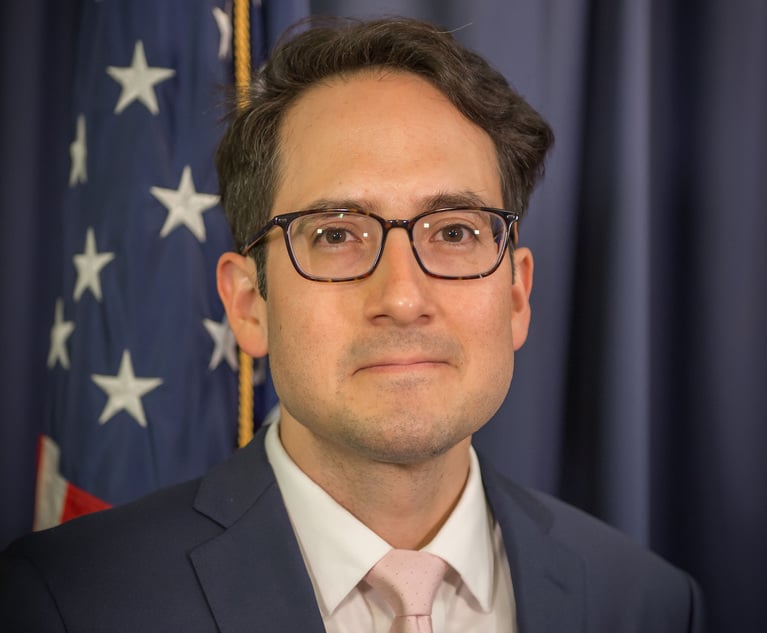Regulatory: Sequestration
The outcome could have a significant impact on the 2012 elections.
September 28, 2011 at 09:13 AM
7 minute read
The original version of this story was published on Law.com
Federal regulatory agencies are facing the threat of extensive budget cuts in their rule writing and enforcement functions under the “sequestration” process under the Deficit Reduction law.
The appropriations process produces budget deficits because program advocates can make strong arguments for increased spending without being required to identify other programs that should be cut to offset those outlays. In 1985, the Gramm-Rudman law “sequestration” mechanism that sought to turn the process into a zero sum game.
“Sequestration” has two meanings. Technically, it means automatic, indiscriminate, pro rata budget cuts to reduce overall spending to a predetermined level. In practice, “sequestration” is a gun that Congress holds to its own head to force program advocates to accept compensating cuts elsewhere for fear that resources for their favorite program otherwise will be cut.
The Deficit Reduction law modified Gramm-Rudman to provide that sequestration will occur in January 2013 unless Congress adopts—by Dec. 23, 2011—a law reducing spending by $1.2 trillion in 2012-2021. If Congress fails to act or adopts a law that reduces spending by less that $1.2 trillion, spending will automatically be reduced in equal amounts over these years to produce $1.2 trillion in cuts.
If sequestration occurs, indiscriminate but uniform pro rata cuts will be divided equally between defense and non-defense programs that have not been exempted. Core national security functions and the major domestic entitlement programs (Social Security and Medicaid) will not be reduced, and cuts in Medicare are limited to 2 percent. The major departure from the original Gramm-Rudman process is that many more national security programs are now subject to sequestration in an effort to force proponents of defense spending to demand cuts in domestic programs in order to prevent reductions in military spending.
The conventional wisdom is that disputes over spending and taxes are so intractable that the Joint Select Committee (JSC) established to draft a deficit reduction law cannot possibly succeed in devising a proposal to save $1.2 trillion that will pass both Houses and that the President will sign. If that prediction is correct and a full sequestration occurs, the Congressional Budget Office estimates that eligible defense programs will be cut by 10 percent, eligible non-defense programs by 7.8 percent and Medicare by 2 percent.
Few regulatory agencies are exempt from sequestration. Budget cuts of this magnitude, extending for nine years, would have substantial adverse effects on regulatory agencies in all their functions, including promulgating rules, supervision of regulated entities, inspections and enforcement. Regulators would be forced to scale back their operations and concentrate of fewer, priority targets. The uniform pro rata cuts would produce similar effects in all other covered programs.
The calculus underlying the sequestration mechanism is that the adverse consequences of extensive, indiscriminate cuts will break the policy deadlock. It is designed to force Congress to end the zero sum game, prioritize among programs and agree to targeted reductions in less-essential programs to avoid extensive cuts in vital programs. The Gramm-Rudman process had this effect in 1985. Although a sequestration was imposed in early 1986, the pro rata amount was small and readily absorbed by the agencies. Congress thereafter took steps to assure that the sequestration experiment was not repeated.
Based on that experience, I believe the most likely outcome of the JSC process is passage of a law that will make substantial progress toward the $1.2 trillion level, with the shortfall covered by a threatened sequestration in January 2013. Whatever the result, this exercise will frame the principal issue for the 2012 elections.
Federal regulatory agencies are facing the threat of extensive budget cuts in their rule writing and enforcement functions under the “sequestration” process under the Deficit Reduction law.
The appropriations process produces budget deficits because program advocates can make strong arguments for increased spending without being required to identify other programs that should be cut to offset those outlays. In 1985, the Gramm-Rudman law “sequestration” mechanism that sought to turn the process into a zero sum game.
“Sequestration” has two meanings. Technically, it means automatic, indiscriminate, pro rata budget cuts to reduce overall spending to a predetermined level. In practice, “sequestration” is a gun that Congress holds to its own head to force program advocates to accept compensating cuts elsewhere for fear that resources for their favorite program otherwise will be cut.
The Deficit Reduction law modified Gramm-Rudman to provide that sequestration will occur in January 2013 unless Congress adopts—by Dec. 23, 2011—a law reducing spending by $1.2 trillion in 2012-2021. If Congress fails to act or adopts a law that reduces spending by less that $1.2 trillion, spending will automatically be reduced in equal amounts over these years to produce $1.2 trillion in cuts.
If sequestration occurs, indiscriminate but uniform pro rata cuts will be divided equally between defense and non-defense programs that have not been exempted. Core national security functions and the major domestic entitlement programs (Social Security and Medicaid) will not be reduced, and cuts in Medicare are limited to 2 percent. The major departure from the original Gramm-Rudman process is that many more national security programs are now subject to sequestration in an effort to force proponents of defense spending to demand cuts in domestic programs in order to prevent reductions in military spending.
The conventional wisdom is that disputes over spending and taxes are so intractable that the Joint Select Committee (JSC) established to draft a deficit reduction law cannot possibly succeed in devising a proposal to save $1.2 trillion that will pass both Houses and that the President will sign. If that prediction is correct and a full sequestration occurs, the Congressional Budget Office estimates that eligible defense programs will be cut by 10 percent, eligible non-defense programs by 7.8 percent and Medicare by 2 percent.
Few regulatory agencies are exempt from sequestration. Budget cuts of this magnitude, extending for nine years, would have substantial adverse effects on regulatory agencies in all their functions, including promulgating rules, supervision of regulated entities, inspections and enforcement. Regulators would be forced to scale back their operations and concentrate of fewer, priority targets. The uniform pro rata cuts would produce similar effects in all other covered programs.
The calculus underlying the sequestration mechanism is that the adverse consequences of extensive, indiscriminate cuts will break the policy deadlock. It is designed to force Congress to end the zero sum game, prioritize among programs and agree to targeted reductions in less-essential programs to avoid extensive cuts in vital programs. The Gramm-Rudman process had this effect in 1985. Although a sequestration was imposed in early 1986, the pro rata amount was small and readily absorbed by the agencies. Congress thereafter took steps to assure that the sequestration experiment was not repeated.
Based on that experience, I believe the most likely outcome of the JSC process is passage of a law that will make substantial progress toward the $1.2 trillion level, with the shortfall covered by a threatened sequestration in January 2013. Whatever the result, this exercise will frame the principal issue for the 2012 elections.
This content has been archived. It is available through our partners, LexisNexis® and Bloomberg Law.
To view this content, please continue to their sites.
Not a Lexis Subscriber?
Subscribe Now
Not a Bloomberg Law Subscriber?
Subscribe Now
NOT FOR REPRINT
© 2025 ALM Global, LLC, All Rights Reserved. Request academic re-use from www.copyright.com. All other uses, submit a request to [email protected]. For more information visit Asset & Logo Licensing.
You Might Like
View All
Fired NLRB Member Seeks Reinstatement, Challenges President's Removal Power

GOP-Led SEC Tightens Control Over Enforcement Investigations, Lawyers Say

GOP Now Holds FTC Gavel, but Dems Signal They'll Be a Rowdy Minority
6 minute read
Trump's Inspectors General Purge Could Make Policy Changes Easier, Observers Say
Trending Stories
Who Got The Work
J. Brugh Lower of Gibbons has entered an appearance for industrial equipment supplier Devco Corporation in a pending trademark infringement lawsuit. The suit, accusing the defendant of selling knock-off Graco products, was filed Dec. 18 in New Jersey District Court by Rivkin Radler on behalf of Graco Inc. and Graco Minnesota. The case, assigned to U.S. District Judge Zahid N. Quraishi, is 3:24-cv-11294, Graco Inc. et al v. Devco Corporation.
Who Got The Work
Rebecca Maller-Stein and Kent A. Yalowitz of Arnold & Porter Kaye Scholer have entered their appearances for Hanaco Venture Capital and its executives, Lior Prosor and David Frankel, in a pending securities lawsuit. The action, filed on Dec. 24 in New York Southern District Court by Zell, Aron & Co. on behalf of Goldeneye Advisors, accuses the defendants of negligently and fraudulently managing the plaintiff's $1 million investment. The case, assigned to U.S. District Judge Vernon S. Broderick, is 1:24-cv-09918, Goldeneye Advisors, LLC v. Hanaco Venture Capital, Ltd. et al.
Who Got The Work
Attorneys from A&O Shearman has stepped in as defense counsel for Toronto-Dominion Bank and other defendants in a pending securities class action. The suit, filed Dec. 11 in New York Southern District Court by Bleichmar Fonti & Auld, accuses the defendants of concealing the bank's 'pervasive' deficiencies in regards to its compliance with the Bank Secrecy Act and the quality of its anti-money laundering controls. The case, assigned to U.S. District Judge Arun Subramanian, is 1:24-cv-09445, Gonzalez v. The Toronto-Dominion Bank et al.
Who Got The Work
Crown Castle International, a Pennsylvania company providing shared communications infrastructure, has turned to Luke D. Wolf of Gordon Rees Scully Mansukhani to fend off a pending breach-of-contract lawsuit. The court action, filed Nov. 25 in Michigan Eastern District Court by Hooper Hathaway PC on behalf of The Town Residences LLC, accuses Crown Castle of failing to transfer approximately $30,000 in utility payments from T-Mobile in breach of a roof-top lease and assignment agreement. The case, assigned to U.S. District Judge Susan K. Declercq, is 2:24-cv-13131, The Town Residences LLC v. T-Mobile US, Inc. et al.
Who Got The Work
Wilfred P. Coronato and Daniel M. Schwartz of McCarter & English have stepped in as defense counsel to Electrolux Home Products Inc. in a pending product liability lawsuit. The court action, filed Nov. 26 in New York Eastern District Court by Poulos Lopiccolo PC and Nagel Rice LLP on behalf of David Stern, alleges that the defendant's refrigerators’ drawers and shelving repeatedly break and fall apart within months after purchase. The case, assigned to U.S. District Judge Joan M. Azrack, is 2:24-cv-08204, Stern v. Electrolux Home Products, Inc.
Featured Firms
Law Offices of Gary Martin Hays & Associates, P.C.
(470) 294-1674
Law Offices of Mark E. Salomone
(857) 444-6468
Smith & Hassler
(713) 739-1250






